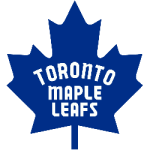The Toronto Maple Leafs are Toronto’s most financially successful sports franchise to date and the holders of 13 Stanley Cups. They were one of the teams that formed the ‘Original Six’ in 1917 when the NHL was first established.
The franchise has altered its name four times since then, and, like its name, its logo has also gone through a few changes over the years.

Toronto Arenas Primary Logo 1919
A total of 14 logos offer insight into the Maple Leafs' history in the NHL, representing significant events. Initially, the team was called the Toronto Arenas, their logo likewise portraying this with an uppercase blue “T” to represent the city of Toronto. In 1918, the logo was reformed to include the word “Arenas” in dark blue behind the original “T.”
Only two years after their establishment, the team’s name was changed to Toronto St. Patricks. This consequently affected the logo and team color. The franchise’s new symbol became “Toronto St Pats,” centralized in green capital letters. This logo remained until 1922, when it then resembled a green pill-shaped background, with the words “St Pats'' inscribed in white across the surface.
However, this logo was short-lived, as it was reverted to the former in 1925.
About two years later, the logo was modified again. The once green letters were changed into white letters with a green outline. Conn Smythe became the manager of the Maple Leafs later that year, spurring the initiation of the maple leaf symbol as the team’s logo. The logo depicted a green 48-point maple leaf - retaining their connection to the St Patrick's era - and their new name (Toronto Maple Leafs) in white, ins

Toronto Maple Leafs Primary Logo 1928 - 1938
cribed inside, with the word “Toronto” placed in a slight downward arch.
This symbol was believed to be inspired by the maple leaf badges worn by Canadian military personnel during WWI. It is also possible that the gold medal-worthy performance of the men’s Olympic hockey team in 1924 influenced the new design since they also sported maple leaves on their jerseys. In subsequent years, the primary team color was returned to its preliminary blue color, as was the maple leaf symbol.
From 1938 to 1963, the franchise added white veins to the leaf. The former 48-point maple leaf now had 35 points and was more symmetrical. The word “Toronto” had also been written in an upward arch. For a few months in 1947, the text did appear in red to contrast with the blue; however, this change was brief, and the original white text was utilized for the remainder of the period.
Given the Toronto Maple Leafs' illustrious past and devoted fan base, it comes as no surprise that the Toronto Maple Leafs are popular among sports bettors. With the legalization of online sports betting in Ontario last year, fans have now been allowed to place wagers on the NHL games of their favorite club through a variety of Ontario Sportsbooks. This allows fans to interact more passionately with their support team and provides extra excitement to view the games.
The designers then decided to enhance the outline of the leaf by adding a white inner border to make it appear more realistic.

Toronto Maple Leafs Primary Logo 1968 - 1970
This design persisted from 1963 to 1967 until a distinctive lettering and leaf structure change occurred in the following three years. The iconic maple leaf was again reduced to an 11-point symmetrical symbol with no veins or white outline. This maple leaf was identical to that on the recently upgraded national Canadian Flag. The text also remained the same, save for rounding the individual letters.
This change occurred significantly in Maple Leafs' history, marking the team’s most recent Stanley Cup win in a season that did not favor them. Being somewhat superstitious characters, Maple Leaf's hockey players hold a special reverence for this particular design. In the following 45 years (1971-2016), there were a few minuscule changes to the logo regarding color, leaf shape, and font. But the 11-point maple leaf generally kept its design.

Toronto Maple Leafs Primary Logo 2016 - Present
In early 2016, the current design was revealed, which bore significant similarities to the 1940-60 design, minus the white veins. This reversion to the older design is due to the franchise’s century of establishment in 2017. Here the points on the leaf hold even more significance as a testament to the Leafs’ history.
The 31-pointed leaf represents 1931, when the team set multiple records in points and wins. Of those, the top-most 13 represent their 13 Stanley Cups, the 31st represents the Maple Leaf Gardens stadium opening, and the remaining 17 signify the year the team was founded.
With this in mind, it’s easy to see why the logo is significant in the Leafs’ community. For a team that shares its country’s symbol and holds the hearts of many hockey fans worldwide, the future will have even more in store for the Toronto Maple Leafs.
Sports Logo History is a community of sports logo enthusiast who enjoys the history of each team’s logo history. Sports Logo History has primary logos, alternate logos, or wordmark logos from the NFL, NBA, MLB, MLS, NHL, Premier League, WNBA, CFL, NCAA, ABA, USFL, AAF, and XFL.
One of our partner sites Sports Team History takes a look at the history of each and every professional sports team. In addition, we have added Sports News History to our sports history websites. 24/7 non-stop sports news that's worth knowing. Finally, the premier sports team marketplace for your favorite team or college with thousands of items for you to peruse at Sports Market History.

